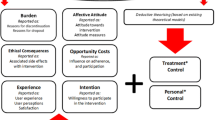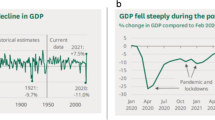Abstract
Purpose
We describe a method we developed for estimating cancer costs from the perspective of patients and caregivers and evidence supporting validity of estimates obtained.
Methods
To increase validity, interview questions were anchored to treatments; costs were divided into their components; most questions focused on facts; and the research team combined responses into cost estimates. Evidence for validity comes from a prospective study of breast cancer costs using this method.
Results
Estimates obtained using interview responses were similar to those from independent sources. Women reported being reimbursed $205 on average for prosthesis (government reimbursement = $200); paying $15.48 per night at cancer lodge (average rate = $17.52); receiving government illness insurance for 14.6 weeks at 53% of usual salary (governmental program covers 15 weeks at 55%). A priori hypotheses about relations of costs with other characteristics were also confirmed. For example, patients’ weekly travel costs increased as a function of distance from the radiotherapy center, with patients living <25, 25–49 and ≥50 km away spending $54, $141 and $240, respectively (P < .0001); and the proportion of annual salary lost was 37% for self-employed workers compared to 18% for employees (P < .0001).
Conclusions
Evidence to date supports the validity of estimates obtained using this method.


Similar content being viewed by others
References
Hillner, B. (1996). Economic and cost-effectiveness issues in breast cancer treatment. Seminars in Oncology, 23(1 (suppl 2)), 98–104.
Pass, C., Lowes, B., & Davies, L. (1993). Collins dictionary of economics. London: Collins.
Collins, D. J., & Lapsey, H. M. (1991). Estimating the economic costs of drug abuse in Australia. National Campaign Against Drug Abuse Monograph Series, 15.
Koopmanschap, M. A., Rutten, F. F. H., & Van der Maas, P. (1993). Indirect costs in economic studies. PharmacoEconomics, 4, 1–9.
Carmines, E., & Zeller, R. (1979). Reliability and validity assessment. Newbury Park: Sage.
Aday, L. A. (1996). Designing and conducting health surveys: A comprehensive guide (2nd ed.). San Francisco: Jossey-Bass.
Agency for Healthcare Research and Quality (AHRQ). (2001). Medical Expenditure Panel Survey Medical Expenditure Panel Survey [questionnaire]. http://www.meps.ahrq.gov/whatis.htm. Accessed June 17, 2009.
Birenbaum, L. K., & Clarke-Steffen, L. (1992). Terminal care costs in childhood cancer. Pediatric Nursing, 18(3), 285–288.
Given, B. A., Given, C. W., & Stommel, M. (1994). Family and out-of-pocket costs for women with breast cancer. Cancer Practice, 2(3), 187–193.
Houts, P. S., Harvey, H. A., Simmonds, M. A., Marshall, M., Gottleib, R., Lipton, A., et al. (1985). Characteristics of patients at risk for financial burden because of cancer and its treatment. Journal Psychosocial Oncology, 3(2), 15–22.
Houts, P. S., Lipton, A., Harvey, H. A., Martin, B., Simmonds, M. A., Dixon, R. H., et al. (1984). Nonmedical costs to patients and their families associated with outpatient chemotherapy. Cancer, 53, 2388–2392.
Houts, P. S., Lipton, A., Harvey, H. A., & Martin, B. A. (1983). A method for collecting detailed data on direct and indirect medical expenses of cancer patients. Progress in Clinical and Biological Research, 120, 193–199.
Lansky, S. B., Cairns, N. U., Clark, G. M., Lowman, J., Miller, L., & Trueworthy, R. (1979). Childhood cancer: Nonmedical costs of the illness. Cancer, 43(1), 403–408.
Moore, K. A. (1999). Breast cancer patients’ out-of-pocket expenses. Cancer Nursing, 22(5), 389–396.
Barr, R. D., Furlong, W., Horsman, J. R., Feeny, D., Torrance, G. W., & Weitzman, S. (1996). The monetary costs of childhood cancer to the families of patients. International Journal of Oncology, 8, 933–940.
Bloom, B. S., Knorr, R. S., & Evans, A. E. (1985). The epidemiology of disease expenses. The costs of caring for children with cancer. Journal of the American Medical Association, 253(16), 2393–2397.
Bodkin, C. M., Pigott, T. J., & Mann, J. R. (1982). Financial burden of childhood cancer. British Medical Journal, 284(6328), 1542–1544.
Monaco, G. P. (1983). Economics as a significant contributor to family stress in childhood cancer. Progress in Clinical and Biological Research, 132E, 387–394.
Stommel, M., Given, C. W., & Given, B. A. (1993). The cost of cancer home care to families. Cancer, 71(5), 1867–1874.
Willis, G. B. (1999). Cognitive Interviewing. A “How to” Guide. Meeting of the American Statistical Association.
Lauzier, S., Maunsell, E., De Koninck, M., Drolet, M., Hebert-Croteau, N., & Robert, J. (2005). Conceptualization and sources of costs from breast cancer: Findings from patient and caregiver focus groups. Psycho-Oncology, 14(5), 351–360.
Frey, J., & Fontana, A. (1993). The group interview in social research. In D. Morgan (Ed.), Successful focus groups: Advancing the state of the art (pp. 20–34). Newbury Park: Sage.
Kitzinger, J. (1995). Introducing focus groups. British Medical Journal, 311, 299–302.
Morgan, D. L. (1998). Focus group as qualitative research. Newbury Park: Sage.
Wolff, B., Knodel, J., & Sittitrai, W. (1993). Focus groups and surveys as complementary research methods: A case example. In D. Morgan (Ed.), Successful focus groups advancing the state of the art (pp. 118–136). Newbury Park: Sage.
Drolet, M., Maunsell, E., & Lauzier, S. (2001). Family costs of breast cancer: Extent, determinants and relation with quality of life. Progress report to the Canadian Breast Cancer Research Alliance (CBCRA). September 1999–August 2001.
Cancer Care Inc. (1973). The impact, costs, and consequences of catastrophic illness on patients and families. A report of a social research study of selected families stricken by advanced cancer. New York: Cancer Care, Inc. and The National Cancer Foundation, Inc.
Maguire, P., Pentol, A., Allen, D., Tait, A., Brooke, M., & Sellwood, R. (1982). Cost of counselling women who undergo mastectomy. British Medical Journal, 284, 1933–1935.
Drolet, M., Maunsell, E., Mondor, M., Brisson, J., Brisson, C., Mâsse, B., et al. (2005). Work absence after breast cancer diagnosis: A population-based study. Canadian Medical Association Journal, 173(7), 765–769.
Maunsell, E., Drolet, M., Ouhoummane, N., & Robert, J. (2005). Breast cancer survivors accurately reported key treatment and prognostic characteristics. Journal of Clinical Epidemiology, 58(4), 364–369.
Drummond, M., Sculpher, M., Torrance, G., O’Brien, B., & Stoddart, G. (2005). Economic evaluation using patient-level data. In M. Drummond, M. Sculpher, G. Torrance, B. O’Brien, & G. Stoddart (Eds.), Methods for the economic evaluation of health care programmes (3rd ed., pp. 247–275). Oxford: Oxford University Press.
Microsoft. (2001). Streets and Trips software.
Lauzier, S., Maunsell, E., Drolet, M., Coyle, D., Hébert-Croteau, N., Brisson, J., et al. (2008). Wage losses in the year after breast cancer: Extent and determinants among Canadian women. Journal of the National Cancer Institute, 100(5), 321–332.
Canadian Government. (2009). Employment Insurance (EI) and maternity, parental and sickness benefits [website]. http://www.servicecanada.gc.ca/eng/ei/types/special.shtml. Accessed June 17, 2009.
Ministère du Travail du Québec. (2004). Portrait statistique des conventions collectives analysées en 2003 au Québec. Québec: Direction des données sur le travail, Ministère du Travail du Québec.
Calhoun, E. A., Chang, C. H., Welshman, E. E., Fishman, D. A., Lurain, J. R., & Bennett, C. L. (2001). Evaluating the total costs of chemotherapy-induced toxicity: Results from a pilot study with ovarian cancer patients. Oncologist, 6(5), 441–445.
Ihbe-Heffinger, A., Ehlken, B., Bernard, R., Berger, K., Peschel, C., Eichler, H. G., et al. (2004). The impact of delayed chemotherapy-induced nausea and vomiting on patients, health resource utilization and costs in German cancer centers. Annals of Oncology, 15(3), 526–536.
Moore, K. (1998). Out-of-pocket expenditures of outpatients receiving chemotherapy. Oncology Nursing Forum, 25(9), 1615–1622.
O’Brien, B. J., Rusthoven, J., Rocchi, A., Latreille, J., Fine, S., Vandenberg, T., et al. (1993). Impact of chemotherapy-associated nausea and vomiting on patients’ functional status and on costs: Survey of five Canadian centres. Canadian Medical Association Journal, 149(3), 296–302.
Sculpher, M., Palmer, M. K., & Heyes, A. (2000). Costs incurred by patients undergoing advanced colorectal cancer therapy. A comparison of raltitrexed and fluorouracil plus folinic acid. PharmacoEconomics, 17(4), 361–370.
Arozullah, A. M., Calhoun, E. A., Wolf, M., Finley, D. K., Fitzner, K. A., Heckinger, E. A., et al. (2004). The financial burden of cancer: Estimates from a study of insured women with breast cancer. Journal of Supportive Oncology, 2(3), 271–278.
Chan, A., Jacobs, P., Yeo, W., Lai, M., Hazlett, C., Mok, T., et al. (2001). The cost of palliative care for hepatocellular carcinoma in Hong Kong. PharmacoEconomics, 19(9), 947–953.
Longo, C. J., Fitch, M., Deber, R. B., & Williams, A. P. (2006). Financial and family burden associated with cancer treatment in Ontario, Canada. Supportive Care in Cancer, 14(11), 1077–1085.
Schulz, R., Williamson, G. M., Knapp, J. E., Bookwala, J., Lave, J., & Fello, M. (1995). The psychological, social, and economic impact of illness among patients with recurrent cancer. Journal of Psychosocial Oncology, 13(3), 21–45.
Sherman, E. J., Pfister, D. G., Ruchlin, H. S., Rubin, D. M., Radzyner, M. H., Kelleher, G. H., et al. (2001). The collection of indirect and nonmedical direct costs (COIN) form: A new tool for collecting the invisible costs of androgen independent prostate carcinoma. Cancer, 91(4), 841–853.
Butler, L., Downe-Wamboldt, B., Melanson, P., Coulter, L., Keefe, J., Singleton, J., et al. (2006). Prevalence, correlates, and costs of patients with poor adjustment to mixed cancers. Cancer Nursing, 29(1), 9–16.
Gordon, L., Scuffham, P., Hayes, S., & Newman, B. (2007). Exploring the economic impact of breast cancers during the 18 months following diagnosis. PsychoOncology, 16(12), 1130–1139.
Grunfeld, E., Coyle, D., Whelan, T., Clinch, J., Reyno, L., Earle, C. C., et al. (2004). Family caregiver burden: Results of a longitudinal study of breast cancer patients and their principal caregivers. Canadian Medical Association Journal, 170(12), 1795–1801.
Thorpe, K. E., & Howard, D. (2003). Health insurance and spending among cancer patients. Health Affairs (Suppl Web Exclusives), W3, 189–198.
Langa, K. M., Fendrick, A. M., Chernew, M. E., Kabeto, M. U., Paisley, K. L., & Hayman, J. A. (2004). Out-of-pocket health-care expenditures among older Americans with cancer. Value in Health, 7(2), 186–194.
Muller-Nordhorn, J., Bruggenjurgen, B., Bohmig, M., Selim, D., Reich, A., Noesselt, L., et al. (2005). Direct and indirect costs in a prospective cohort of patients with pancreatic cancer. Alimentary Pharmacology & Therapeutics, 22(5), 405–415.
Lidgren, M., Wilking, N., Jonsson, B., & Rehnberg, C. (2007). Resource use and costs associated with different states of breast cancer. International Journal of Technology Assessment in Health Care, 23(2), 223–231.
Foddy, W. (1993). Constructing questions for interviews and questionnaires. Cambridge: Cambridge University Press.
Acknowledgments
We thank the women and caregivers who participated in the different phases of the Family Costs of Breast Cancer Study, and the study coordinator, interviewers, data manager, statisticians and the members of the Family Costs of Breast Cancer Clinician Collaborators Group (Michèle Brie (Centre hospitalier régional de Baie-Comeau, Baie-Comeau), Judith Gaudreault (Centre hospitalier régional du Grand-Portage, Rivière-du-Loup), Marie-Hélène Girouard (Centre hospitalier régional de Trois-Rivières, Trois-Rivières), Jean Robert (Hôpital du Saint-Sacrement, Québec), André Robidoux (Centre hospitalier de l’Université de Montréal, Montréal), Mathieu Roy (Centre hospitalier Pierre-Boucher, Longueuil), Renée Simon (Hôpital Charles-Lemoyne, Greenfield Park), and Éric Imbeau (Hôtel-Dieu de Lévis, Lévis)). Funding: This work was supported by competitive funding from the Canadian Breast Cancer Research Alliance (grants #010318, #013324, #017317); the Ministère de la Santé et des Services Sociaux du Québec, the Canadian Institutes of Health Research (Investigator award for E. M., Ph.D. Fellowship Award for S. L.); the Fondation de l’Université Laval (Ph.D. Fellowship Award for S. L.) and the Psychosocial Oncology Research Training (PORT) program of the Canadian Institutes of Health Research—funded Strategic Training Initiative in Health Research (STIHR) (Post-doctoral Fellowship Award for S. L.).
Author information
Authors and Affiliations
Corresponding author
Appendix
Appendix
See Table 3.
Rights and permissions
About this article
Cite this article
Lauzier, S., Maunsell, E., Drolet, M. et al. Validity of information obtained from a method for estimating cancer costs from the perspective of patients and caregivers. Qual Life Res 19, 177–189 (2010). https://doi.org/10.1007/s11136-009-9575-y
Accepted:
Published:
Issue Date:
DOI: https://doi.org/10.1007/s11136-009-9575-y




